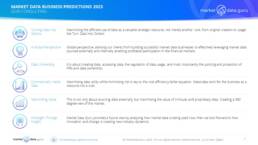FIVE THOUGHTS ON WHAT THE YEAR WILL BRING

CRYSTAL BALLS
Here are my 5 predictions for the world of market data in 2023 which will be developed further in 5 short articles:
1.Data Costs Return as an Issue. It is fun listening to market data managers at big institutions explaining how effectively they have costs under control. Few really do, and we estimate that data consumers over spend by between 25% and 35% on average. Equally as the demand increases axiomatically costs do to, especially when driven by regulatory fiat and other factors outside of a business’ control. Nevertheless, weakening profits will drive the bean counters to cut costs, and data being one of the largest is an obvious target. However, this will prove harder to achieve in than previously due to contractual obligations, the difficulty in removing data integrated into networked systems, and smaller organisations not having the internal experience to thoroughly optimise their market data costs.
2.Total Information Management. Market Data has always been seen as somewhat unique, and to be fair there is a great deal of truth in this because it relies upon high levels of real time delivery and bleeding edge technology. The impact of ‘The Cloud’ and belatedly ‘Big Data’ is changing the dynamic especially given the rise of Alternative Data, Commercial Data, and ESG which can be integrated into existing datasets. What this means is financial institutions and vendors are going to have to change from micro to macro management of data, i.e. managing all digital content as non-market data information suppliers adopt commercial and contractual models from their more advanced market data brethren. There is also a technology impact as more information from a greater number of sources are shared on the same platforms,
3.Mergers & Acquisitions. Recently market data has attracted large outsiders like Amazon, Google, and Microsoft, not with big deals but more stepping their toes into the waters through small stakes and partnerships. Notably these players are providing reach and distribution and their partners of choice are not vendors but the large owners of proprietary data, i.e. the big exchanges. This is bringing together distribution and content backed by strong competitive edges, something MDG highlighted in 2021. In 2023 more such deals are likely, plus Private Equity looking for strong data and analytics based market data vendors to invest in. At the smaller end of the spectrum, Reference and Historical data suppliers are likely to be in vogue, providing consolidation in this space for companies seeking to build their content inventory.
As MDG says every year look out for a Bloomberg blockbuster. One day this prediction will come true.
4.Discovering New Markets. Exchanges, Data Sources, and Vendors have woken up to the realisation their core client base the financial institutions have hit data saturation point but still struggle to find new markets and strategies, despite this for the most part staring them in the face. For instance, the development of third party processing and facilitation, including algo trading smart order routing, post trade data inputs & outputs, any area of data processing that can be done in bulk by more efficient external organisations supporting multiple institutions. Equally renewed emphasis on the mass digital market linked to trading as epitomised by TradingView and BarChart which are tying up with brokers are drawing trading into new flows, especially in the Crypto and FX markets. This trend is going to strengthen and bypass legacy based thinking. A major switch is the increase in value of analytics and historic data for strategic trading, investors realising real time prices should be used more tactically.
5.Discovering New Business Models. Exchanges and Data Sources will discover their existing business and pricing models don’t work for them, nor their clients, nor their potential new markets in a world where the banks have hit saturation point. This should lead to an overhaul in business strategies, pricing models, data workflows and partnerships. Improved structures should be targeting two specific areas, firstly tailoring services and pricing around real world market data usage, and secondly the high levels of revenue leakage that is occurring though poor and ineffective reporting. By adopting smarter business models this will also have the added benefit of blunting the impact of ill-informed regulators will almost certainly have if they seek to gerrymander the data marketplace. Likelihood of happening in 2023, sadly low.
Summary
In the world of market data change is already a constant by its very nature, the creation of new data catalyses evolution, such that the more data produced in turn generates even more data. The data cycle is dead, the ever expanding data spiral lives. 2023 will not change that.
In 2023 the dynamism that lies behind the myriad ways data becomes malleable for new purposes will force all 3 in the traditional data chain, (a chain that is breaking up) i.e. 1, data sources (Exchanges/IDBs/Index Creators), 2, the vendors, and 3, the data consumers to alter their perceptions of the existing market, how it operates, and embrace new markets which operate outside the comfortable parameters that in realty have ceased to exist.
However, also in 2023 how much data consumers are willing to pay will underline how the year will progress both negatively and positively.
That is an intriguing prospect.
Keiren Harris 10 January 2023
Please contact info@marketdata.guru for a pdf copy of the article
For information on our consulting services please email knharris@datacompliancellc.com


